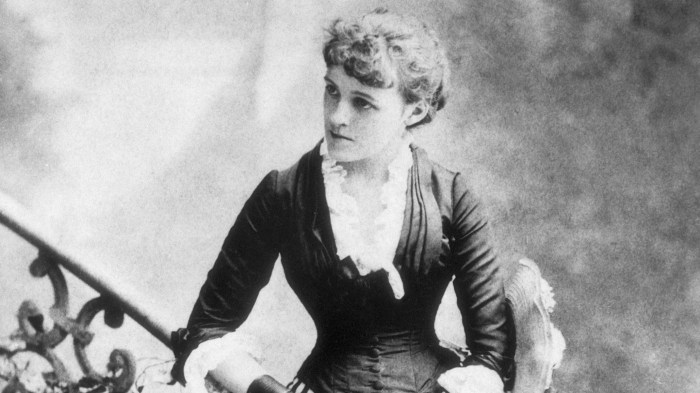Edith wharton ruin of man – Edith Wharton’s “The Ruin of Man” captivates readers with its poignant exploration of the human condition, delving into themes of love, loss, and the complexities of society. This literary masterpiece, crafted with Wharton’s signature prose, offers a compelling narrative that unravels the intricate web of relationships, societal norms, and personal struggles.
The novel centers around Lily Bart, a young woman navigating the treacherous waters of New York’s high society. Her pursuit of love and happiness is constantly challenged by the rigid expectations and social constraints of her time. Wharton’s astute observations on class, gender, and morality paint a vivid picture of the societal landscape that shapes Lily’s destiny.
Edith Wharton’s “The Ruin of Man” Overview

Edith Wharton’s “The Ruin of Man” is a novel that explores the themes of love, marriage, and social class in the Gilded Age of New York City. The novel follows the story of Spencer Rosedale, a wealthy and ambitious young man who marries the beautiful and innocent Lily Bart.
However, their marriage is doomed from the start, as Spencer is more interested in Lily’s money than her love. Lily, for her part, is trapped in a loveless marriage and eventually turns to other men for companionship.
Wharton’s novel is a scathing indictment of the social conventions of her time. She portrays the upper classes as a shallow and materialistic society, where women are valued only for their beauty and wealth. Lily Bart is a tragic figure, a woman who is both a victim of her circumstances and her own choices.
Wharton’s novel is a powerful and moving story that explores the complex and often contradictory nature of love and marriage.
Historical and Social Context
Edith Wharton’s “The Ruin of Man” was published in 1905, during a period of great social and economic change in the United States. The Gilded Age was a time of great wealth and prosperity, but it was also a time of great inequality.
The gap between the rich and the poor was growing wider, and the upper classes were becoming increasingly isolated from the rest of society. Wharton’s novel reflects this social divide, and it explores the ways in which the wealthy and the poor interact with each other.
Character Analysis: Lily Bart

Lily Bart, the protagonist of Edith Wharton’s “The Ruin of Man,” is a complex and fascinating character. Her motivations, desires, and flaws are intricately intertwined, and her relationships with men are often fraught with tension and ambiguity.
Lily is a beautiful and intelligent young woman who longs for social acceptance and financial security. She is aware of her own worth and is determined to marry well. However, she is also proud and independent, and she refuses to compromise her principles for the sake of a wealthy husband.
Lily’s Motivations and Desires
- To find a wealthy and socially acceptable husband.
- To live a life of luxury and comfort.
- To be admired and respected by others.
Lily’s Flaws
- She is too proud and independent.
- She is often indecisive and lacks self-confidence.
- She is too trusting of others.
Lily’s Relationships with Men
Lily’s relationships with men are often complex and ambiguous. She is attracted to men who are wealthy and powerful, but she is also drawn to men who are kind and intelligent. She is often torn between her desire for social acceptance and her own personal happiness.
One of Lily’s most significant relationships is with Lawrence Selden. Selden is a wealthy and successful lawyer who is also a close friend of Lily’s. Selden is attracted to Lily’s intelligence and independence, but he is also aware of her flaws.
He is often critical of her, but he also cares deeply for her.
Another important relationship in Lily’s life is with Percy Gryce. Gryce is a wealthy and socially acceptable man who is in love with Lily. However, Lily does not love Gryce, and she is only interested in him for his money.
She eventually marries Gryce, but the marriage is unhappy.
Lily’s Social Status and Gender
Lily’s social status and gender have a profound impact on her life. As a woman in the early 20th century, Lily is expected to marry and have children. However, she is also ambitious and intelligent, and she longs for a life that is more than just domesticity.
Lily’s social status also affects her relationships with men. She is often seen as a threat by men who are threatened by her intelligence and independence. This makes it difficult for her to find a man who is truly equal to her.
Society and Morality in “The Ruin of Man”

Edith Wharton’s “The Ruin of Man” presents a sharp critique of the upper-class society of New York City in the late 19th century. The novel explores the ways in which social norms and expectations shape characters’ actions and ultimately lead to their downfall.
Social Norms and Expectations
The upper-class society depicted in the novel is governed by a rigid set of social norms and expectations. These norms dictate everything from the way people dress and behave to the people they marry. Characters who violate these norms are ostracized from society.
The Role of Money, Reputation, and Marriage, Edith wharton ruin of man
Money, reputation, and marriage play a central role in shaping characters’ actions in “The Ruin of Man.” Characters are constantly striving to maintain their financial status and social standing. Marriage is seen as a way to secure financial stability and social status, rather than a union based on love and compatibility.
Consequences of Violating Societal Norms
The consequences of violating societal norms are severe in “The Ruin of Man.” Characters who step outside of the boundaries of acceptable behavior are punished with social isolation and financial ruin. The novel shows how the pressure to conform to social expectations can lead to tragic consequences.
Literary Techniques in “The Ruin of Man”

Edith Wharton’s “The Ruin of Man” is a masterfully crafted novel that employs a range of literary techniques to enhance its themes and create a captivating narrative. Wharton’s use of symbolism, imagery, and foreshadowing enriches the novel’s depth, while its structure and narrative techniques contribute to its emotional impact and ambiguity.
Symbolism
Symbolism plays a crucial role in “The Ruin of Man.” Wharton uses objects, colors, and actions to represent abstract ideas and emotions. For instance, the color green is associated with growth and vitality, while red symbolizes passion and danger. The novel’s central character, Lily Bart, is often depicted in association with flowers, which symbolize her beauty and fragility.
Imagery
Wharton’s vivid and evocative imagery transports readers into the opulent world of Gilded Age New York. She paints detailed descriptions of grand mansions, lavish parties, and elegant clothing, creating a sense of both allure and superficiality. The novel’s sensory imagery also heightens its emotional impact, as readers experience Lily’s joys and sorrows alongside her.
Foreshadowing
Wharton skillfully uses foreshadowing to create a sense of impending doom throughout the novel. Subtle hints and ominous events foreshadow Lily’s tragic fate, building tension and suspense. For example, the novel’s opening chapter describes Lily as “a creature of impulses,” a foreshadowing of her reckless behavior that ultimately leads to her downfall.
Structure and Narrative Techniques
The novel’s structure and narrative techniques contribute to its emotional impact and ambiguity. Wharton uses a non-linear narrative to jump between past and present, creating a sense of disorientation and mirroring Lily’s own inner turmoil. The novel’s third-person narration provides an omniscient perspective, but Wharton also incorporates Lily’s subjective point of view, blurring the lines between truth and perception.
Irony and Ambiguity
Irony and ambiguity abound in “The Ruin of Man.” Lily’s pursuit of social status and financial security ultimately leads to her ruin, creating a tragic irony. Wharton also leaves many aspects of the novel open to interpretation, allowing readers to draw their own conclusions about the characters’ motivations and the novel’s meaning.
Themes in “The Ruin of Man”

Edith Wharton’s “The Ruin of Man” explores a range of profound themes that delve into the human condition and the complexities of society. These themes are interwoven through the characters and plot, providing a nuanced and thought-provoking examination of human nature.
Edith Wharton’s “The Ruins of Man” explores the complexities of human nature and the destructive power of passion. For a deeper understanding of the scientific principles that govern our world, refer to the Ohm’s Law Lab Answer Key . Returning to Wharton’s masterpiece, we delve further into the intricate web of emotions and the consequences of unchecked desire that drive her characters to ruin.
Love and Loss
Love and loss are central themes in the novel. Lily Bart’s pursuit of love and her subsequent disillusionment highlight the transformative power of both love and its absence. The novel also explores the complexities of romantic relationships, the sacrifices individuals make for love, and the devastating consequences of betrayal.
The Pursuit of Happiness
Lily Bart’s relentless pursuit of happiness drives much of the novel’s plot. Wharton examines the societal pressures that shape individuals’ desires and the often unattainable nature of true happiness. The novel explores the sacrifices individuals make in the pursuit of happiness and the compromises they must accept to fit into societal expectations.
Society and Morality
Wharton’s novel provides a sharp critique of the rigid social norms and moral codes of the upper-class society in which Lily Bart lives. The novel exposes the hypocrisy and superficiality of this society, where appearances and social status hold more value than genuine virtue.
Wharton also explores the consequences of violating these societal expectations and the social ostracism that can result.
Legacy and Impact of “The Ruin of Man”
Edith Wharton’s “The Ruin of Man” has left a lasting legacy in the literary world and beyond. Its critical acclaim and popular success have solidified its place as a classic of American literature.
Critical Reception
Upon its publication in 1905, “The Ruin of Man” was met with widespread critical acclaim. Critics praised Wharton’s sharp wit, incisive social commentary, and nuanced characterization. The novel won the Pulitzer Prize in 1921, becoming the first novel by a woman to receive this prestigious honor.
Influence on Literature and Culture
“The Ruin of Man” has had a profound influence on subsequent literature and culture. Its exploration of themes such as social class, morality, and the role of women has resonated with readers for generations. The novel has been adapted into several films and television series, further extending its reach.
Relevance in Contemporary Society
Despite being written over a century ago, “The Ruin of Man” remains relevant and significant in contemporary society. Its depiction of the complexities of social stratification, the struggles faced by women, and the consequences of moral choices continues to resonate with readers today.
FAQ Compilation: Edith Wharton Ruin Of Man
What is the main conflict in “The Ruin of Man”?
The main conflict revolves around Lily Bart’s struggle to reconcile her personal desires with the expectations of society.
How does Wharton explore the theme of love in the novel?
Wharton portrays love as a complex and multifaceted emotion, often intertwined with societal pressures and personal sacrifices.
What is the significance of Lily Bart’s social status in the story?
Lily’s social status as a wealthy but unmarried woman significantly influences her choices and the challenges she faces.